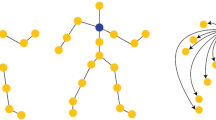Abstract
An automatic human shape-motion analysis method based on a fusion architecture is proposed for human action recognition in videos. Robust shape-motion features are extracted from human points detection and tracking. The features are combined within the Transferable Belief Model (TBM) framework for action recognition. The TBM-based modelling and fusion process allows to take into account imprecision, uncertainty and conflict inherent to the features. Action recognition is performed by a multilevel analysis. The sequencing is exploited for feedback information extraction in order to improve tracking results. The system is tested on real videos of athletics meetings to recognize four types of jumps: high jump, pole vault, triple jump and long jump.
Preview
Unable to display preview. Download preview PDF.
Similar content being viewed by others
References
Aggarwal, J., Park, S.: Human motion: Modeling and recognition of actions and interactions. In: 3DPVT 2004, pp. 640–647 (2004)
Wang, L., Hu, W., Tan, T.: Recent developments in human motion analysis. PR 36(3), 585–601 (2003)
Panagiotakis, C., Tziritas, G.: Recognition and tracking of the members of a moving human body. In: Perales, F.J., Draper, B.A. (eds.) AMDO 2004. LNCS, vol. 3179, pp. 86–98. Springer, Heidelberg (2004)
Odobez, J.M., Bouthemy, P.: Robust multiresolution estimation of parametric motion models. J. of Vis. Comm. and Image R. 6(4), 348–365 (1995)
Luo, Y., Wu, T.D., Hwang, J.N.: Object-based analysis and interpretation of human motion in sports video sequences by dynamic bayesian networks. CVIU 92, 196–216 (2003)
Rombaut, M., Jarkass, I., Denœux, T.: State recognition in discrete dynamical systems using petri nets and evidence theory. In: Hunter, A., Parsons, S. (eds.) ECSQARU 1999. LNCS, vol. 1638, p. 352. Springer, Heidelberg (1999)
Ramasso, E., Pellerin, D., Panagiotakis, C., Rombaut, M., Tziritas, G., Lim, W.: Spatio-temporal information fusion for human action recognition in videos. In: 13th European Signal Processing Conf. (2005)
Smets, P., Kennes, R.: The Transferable Belief Model. Artificial Intelligence 66(2), 191–234 (1994)
Ramasso, E., Rombaut, M., Pellerin, D.: A temporal belief filter improving human action recognition in videos. In: ICASSP (to appear, 2006)
Author information
Authors and Affiliations
Editor information
Editors and Affiliations
Rights and permissions
Copyright information
© 2006 Springer-Verlag Berlin Heidelberg
About this paper
Cite this paper
Panagiotakis, C., Ramasso, E., Tziritas, G., Rombaut, M., Pellerin, D. (2006). Shape-Motion Based Athlete Tracking for Multilevel Action Recognition. In: Perales, F.J., Fisher, R.B. (eds) Articulated Motion and Deformable Objects. AMDO 2006. Lecture Notes in Computer Science, vol 4069. Springer, Berlin, Heidelberg. https://doi.org/10.1007/11789239_40
Download citation
DOI: https://doi.org/10.1007/11789239_40
Publisher Name: Springer, Berlin, Heidelberg
Print ISBN: 978-3-540-36031-5
Online ISBN: 978-3-540-36032-2
eBook Packages: Computer ScienceComputer Science (R0)




